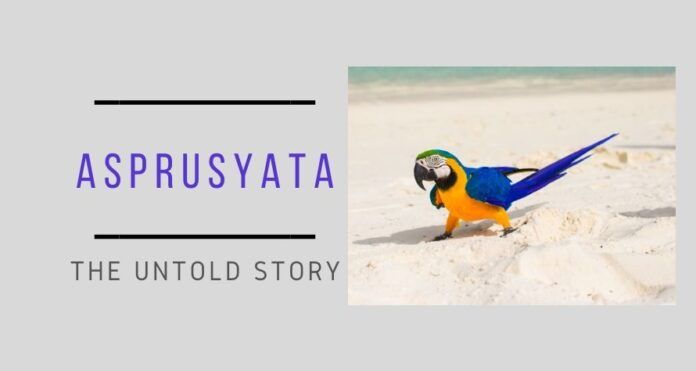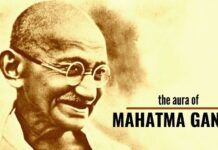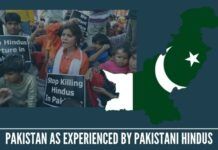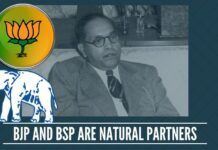
ॐ
The whole world along with many Indians (well meaning, but misguided) think “Asprusyata” is a disease and Brahmins are the root cause of it. Due to the extensive missionary propaganda, it is widely known that the rules of Saucham (Purity) are particularly followed by Brahmins, thus demonizing them as wholly and solely responsible for “Asprusyata”.
In the current situation of Covid-19, the Western world is very vocal about social distancing. In a way, isn’t this also Asprusyata? Since, it is being followed by everyone (read Western world), it is believed that there is no discrimination here. It is important to note that, if a practice becomes the general norm of the society, then there is no discrimination perceived.
Maha Mahopadhyaya Shri P.V. Kane believes that these rules of Saucham are designed not due to hardness of heart, racial or caste pride, but for Adhyatmika Sadhana.

P. V. Kane History of Dharmashastra [1]
Talking about Asprusyata eventually leads the discussion to the practice of Untouchability in India and one cannot talk about Untouchability without invoking Dr. Ambedkar. There are many reasons discussed by Dr. Ambedkar for this Untouchability. The key possibilities which he discussed in his book “The Untouchables” regarding the practice are –
- Do the Untouchables and other castes belong to different races?
- Is it due to the profession?
- Is it due to conversion from Buddhism?
- Is it due to the practice of eating “beef”?
The argument put forth by Ambedkar in the book is tenuous to say the least. Ambedkar admits to the fact that this phenomenon was recorded by Evangelical Missionaries and British authorities in South India. He refers Abbe Dubois, a well-known French Christian Missionary, who lived among Hindus in South India over a decade and wrote a book on the manners and habits of Hindus. Dr. Ambedkar quoting Abbe Dubois;
“Even to this day a Pariah is not allowed to pass a Brahmin street in a village, though nobody can prevent or prevents his approaching or passing by a Brahmin’s house in towns. The Pariahs, on their part will under no circumstances, allow a Brahmin to pass through their paracherries (collection of Pariah huts) as they firmly believe it will lead to their ruin”. [2]
In another example, Dr. Ambedkar quotes Mr. Hemingsway, The Editor of the Gazetteer of the Tanjore district “These castes (Parayan and Pallan or Chakkiliyan castes of Tanjore District) strongly object to the entrance of a Brahmin into their quarters believing that harm will result to them therefrom”. [2]
Dr. Ambedkar also quotes Captain J.S.F. Mackenzie discussing a scenario referring to Holeyas from the Hasan District of Mysore. He said that “…..Brahmins consider that great luck will wait upon them if they can manage to pass through the Holigiri without being molested. To this, Holiars have a strong objection, and, should a Brahmin attempt to enter their quarters, they turn out in a body and slipper him, in former times, it is said, to death. Members of the other castes may come as far as the door, but they must not enter the house, for that would bring the Holiar bad luck”. [2]
From the above illustrations from Dr. Ambedkar himself, it’s evident that even the castes who were traditionally believed to be “Untouchables” do not want a Brahmin to enter not only their houses, but also their streets. This interesting and curious piece of information is very rarely brought into the public domain. This suppression of information seems more likely by design than by an oversight. All these years, we have been told that Asprusyata is caused by Brahmins and their obsession with Saucham. Here, we have completely different examples that illustrate the contrary, from Dr. Ambedkar himself. After all, who is to blame for selectively quoting Dr. Ambedkar?
Anyone who is genuinely pursuing the causes for Untouchability would enquire into these scenarios. Now, let’s look at what Dr. Ambedkar said in relation to this,
“….Unfortunately, the study of the totemic organization of the Hindus and the untouchables has not yet been undertaken by students of anthropology. When such data is collected it would enable us to give a decisive opinion on the question raised in this chapter. For present, I am satisfied from such inquiries as I have made that the totems of the Untouchables of a particular village differ from the totems of the Hindus of the village.” [3]
Dr. Ambedkar genuinely seemed to admit that he does not have enough data from Anthropological Studies and theorizes several hypotheses in his writings, which in his opinion, could possibly be the reasons for Untouchability. He also said that he was happy with the information he had. For an inquisitive and curious mind, few questions should arise from what he said.
- How do we know that the data Dr. Ambedkar had was correct?
- Soon after writing “The Untouchables”, Dr. Ambedkar became Law Minister of India. While he was in power, why did he not undertake/commission the study of such peculiar behavior of the “Untouchables” towards Brahmins?
- How come none of the Christian Missionaries or the Politicians or the Intellectuals (Indian and Western) ever tried to pursue this study yet demonize one community, The Brahmins, as the cause of Untouchability?
- Was there a possibility that Dr. Ambedkar knew the real reasons of Asprusyata?
These are very serious questions which need to be answered. The above social phenomenon (Reverse Untouchability) occurred not just in one, but in multiple places in Madras province and Mysore. There must have been some non-negotiable underlying beliefs/practices that caused them to treat a Brahmin as an Untouchable and keep themselves away from a Brahmin.
The above examples also bare the fact that the practice of Asprusyata was not a one-way street, it was mutual. In the light of such strong evidences, where the Brahmins were subjected to the practice of Reverse Untouchability, one can easily deduce why the British or Christian Missionaries did not want to pursue this study further. Their very existence in India was to rule or convert, and perhaps a study in this direction would not suit their interest.
Many Christian Missionaries and British Officials also recorded another strange phenomenon in South Indian Society. Sudra Varna in South India is divided into Right-Hand and Left-Hand Caste groups that were constantly locking horns with each other for several centuries [4]. This division is completely absent in the current day South Indian Society. The data presented above tells us that there are other possibilities for Untouchability in India. Hence, one must consider the following –
- Are we looking at the Hindu Society through a Christian Missionary lens?
- Are the reasons we believe as the cause of Untouchability wrong?
- Are the divisions and classifications used by the Christian Missionaries and the British Officials fundamentally flawed regarding Caste?
- What if the very definition of Caste or Kulam is wrong?
It’s important to note that, here the discussion is not about discrimination; it’s about the underlying premise of the phenomenon called Untouchability. This is because Hindu Samaj is guilt tripped and constantly held at gunpoint for the practice of Untouchability without understanding it. Several measures, prescriptions and reparations are suggested to the Hindus without correctly diagnosing the problem in the first place.
What is being presented in this article is just the tip of the iceberg of a study that is being undertaken on this critical topic of Untouchability. The preliminary findings and observations I shared with a few Hindu Intellectuals reinforced my point of view regarding this issue. These new insights in connecting the dots will be in the public domain soon which are bound to surprise many. Hence, I am of the view that Historical/Anthropological books of the West and the East may have to be rewritten.
ॐ शान्तिः शान्तिः शान्तिः
Note:
1. The views expressed here are those of the author and do not necessarily represent or reflect the views of PGurus.
References:
[1] P.V. Kane-History of Dharmasastra- Vol 2-1-p170
[2] The Untouchables- B. R. Ambedkar-p75
[3] The Untouchables- B. R. Ambedkar-p32
[4] Kuhana Medho Niyantalu – https://amzn.to/2ISHG8C
- Hidden side of Asprusyata – The untold story - May 4, 2020
- P-3: Chidambaram betrays ex-PM Rajiv Gandhi posthumously? - June 7, 2017
- P-2 : Chidambaram betrays ex-PM Rajiv Gandhi posthumously? - June 4, 2017











[…] [14] https://www.pgurus.com/asprusyata/ […]
If you knew you would be lynched for touching a Brahmin making him impure, what would you do?
Keeping miles away from him would be a wise choice
This is a good beginning. I can understand the urge to point fingers at missionaries and Christians, but it would be better if the author avoided that.
Do have a look at Yog and other texts. You are likely to find some very fundamental statements about the tendencies of a sadhak. Those will help isolate this issue from politics. Leave the politics to others.
The author tries mischievously to explain away discrimination as a concoction of christian propaganda and western obfuscation.The age old traumatic experience of the oppressed was part of the Vedic culture.Vedas portrayed Brahmins, Kshatriyas, and vysyas as the previleged classes:they performed Vedic rituals exclusively, only Kshatriyas were the rulers, and Vysyas carried on all business activities:sudras and mleschas undertook physical labor.
Varnasrama dharma, synonymous with discrimination,finds approval in Ramayana and Mahabharata.I don’t see any justification for this futile hair splitting.All you need is a visit to any of our villages with a discerning,open mind and a sympathetic heart
u hv the adhikar to hold a communist viewpoint …but nobody has the adhikar to hold the opposite view but u r on the “good”/”right” side…u will not be allowed to stop others from presenting their views…
May be some type of virus caused the peole to practice untouchability as they were not medically knowledgable as today.
U have misunderstood the reasons of these findings. What we know only from western lenses.
I think Brahmins maintained untouchability for fear of contracting contagious diseases like Pneumonia, Smallpox, Cholera, Tuberculosis etc. Once contracted, it will culminate in death only as there were no effective treatment.
In Kerala, they never used to eat from outside, always drank only water boiled with dried ginger, never used to enter inside the house with out taking bath, once they go out and do ablution thrice a day etc. Those who criticised and ridiculed them for this are understanding now the importance of social distancing.
Brilliant,,First time a hindu has spent his time and money to understand past practices without depending on whiteman’s tales,,unfortunately rich hindus of whichever caste is more interested in wasting money on idiotic things like gold or properties instead of investing part of loot to unravel our past..I haven’t come across more selfish self destructive group of people than the rich hindus of India..All research has to be unpartisan with the objective of getting at the truth,,present day hindu compromised morally is in capable of pursuing it but atleast rich hindus part with their loot to help those who are pursuing our past. They need help.
I’m disappointed to say that your articles are fast becoming a Brahmin-mouthpiece instead of removing the social differences, uniting and protecting the Hindus.
U have misunderstood the reasons of these findings. What we know only from western lenses.
u shud note that gyan alone removes agyan…by calling anything “brahmin mothpiece” u seem to suggest that pgurus should not work for gyan but work to satisfy your emotional desires…if u present your point of view/arguement it will be much better…
This Reverse Untouchability was also practiced within Dalits. Ex: Mala and Madiga in Andhra/ Telangana never visited their own houses.
Untouchability is a sustained century-long campaign to malign one section of society to divide Hindus and inject guilt about their religion.
Well-written with evidences